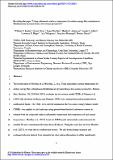Por favor, use este identificador para citar o enlazar a este item:
http://hdl.handle.net/10261/345478COMPARTIR / EXPORTAR:
 SHARE SHARE
 CORE
BASE CORE
BASE
|
|
| Visualizar otros formatos: MARC | Dublin Core | RDF | ORE | MODS | METS | DIDL | DATACITE | |

| Título: | Revisiting the paper “Using radiometric surface temperature for surface energy flux estimation in Mediterranean drylands from a two-source perspective” |
Autor: | Kustas, William P.; Nieto, Héctor CSIC ORCID ; Morillas, Laura CSIC; Anderson, M. C.; Alfieri, Joseph G.; Hipps, Lawrence E.; Villagarcía, Luis; Domingo, Francisco CSIC ORCID; García, Mónica | Fecha de publicación: | oct-2016 | Editor: | Elsevier | Citación: | Remote Sensing of Environment 184: 645-653 (2016) | Resumen: | The recent paper by Morillas et al. [Morillas, L. et al. Using radiometric surface temperature for surface energy flux estimation in Mediterranean drylands from a two-source perspective, Remote Sens. Environ. 136, 234–246, 2013] evaluates the two-source model (TSM) of Norman et al. (1995) with revisions by Kustas and Norman (1999) over a semiarid tussock grassland site in southeastern Spain. The TSM - in its current incarnation, the two-source energy balance model (TSEB) - was applied to this landscape using ground-based infrared radiometer sensors to estimate both the composite surface radiometric temperature and component soil and canopy temperatures. Morillas et al. (2013) found the TSEB model substantially underestimated the sensible H (and overestimated the latent heat LE) fluxes. Using the same data set from Morillas et al. (2013), we were able to confirm their results. We also found energy transport and exchange behavior derived from primarily the observations themselves to differ significantly from a number of prior studies using land surface temperature for estimating heat fluxes with one-source modeling approaches in semi-arid landscapes. However, revisions to key vegetation inputs to TSEB and the soil resistance formulation resulted in a significant reduction in the bias and root mean square error (RMSE) between model output of H and LE and the measurements compared to the prior results from Morillas et al. (2013). These included more representative ground-based vegetation greenness and local leaf area index values as well as modifications to the coefficients of the soil resistance formulation to account for the very rough (rocky) soil surface conditions with a clumped canopy. This indicates that both limitations in remote estimates of biophysical indicators of the canopy at the site and the lack of adjustment in soil resistance formulation to account for site specific characteristics, contributed to the earlier findings of Morillas et al. (2013). This suggests further studies need to be conducted to reduce the uncertainties in the vegetation and land surface temperature input data in order to more accurately assess the effects of the transport exchange processes of this Mediterranean landscape on TSEB formulations. | Versión del editor: | https://doi.org/10.1016/j.rse.2016.07.024 | URI: | http://hdl.handle.net/10261/345478 | DOI: | 10.1016/j.rse.2016.07.024 | ISSN: | 0034-4257 | E-ISSN: | 1879-0704 |
| Aparece en las colecciones: | (ICA) Artículos (EEZA) Artículos |
Ficheros en este ítem:
| Fichero | Descripción | Tamaño | Formato | |
|---|---|---|---|---|
| Revisiting_RSE_2016_ps.pdf | 1,52 MB | Adobe PDF |  Visualizar/Abrir |
CORE Recommender
SCOPUSTM
Citations
58
checked on 29-abr-2024
WEB OF SCIENCETM
Citations
52
checked on 23-feb-2024
Page view(s)
15
checked on 30-abr-2024
Download(s)
7
checked on 30-abr-2024
Google ScholarTM
Check
Altmetric
Altmetric
Este item está licenciado bajo una Licencia Creative Commons

